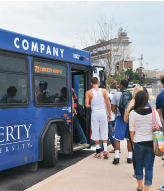Transit company continues service to Liberty University
The Greater Lynchburg Transit Company (GLTC) underwent a change in management over the summer after a fiscal year where the company had to impose service cuts, hikes in bus fares and layoffs in an effort to avoid debt.
The company has been in partnership with Liberty University since 2007 in an effort to offer an on-campus bus service that could reduce traffic and help students in need of getting to class quickly.
According to the Virginia transit website, both the university and GLTC saw almost immediate positive results from the partnership.
An article on the Virginia transit website says that the service, which began with six buses, was so popular on campus that the university devised a plan to increase the number to 12 in peak hours and eventually added off-campus services to pick up commuters from housing developments with high concentrations of Liberty students.
GLTC saw the city’s total ridership double following this partnership. A News and Advance article documented the bus company’s financial trouble during the 2011-12 fiscal year, which ended in July. Karen Walton replaced Mike Carroll in late July. Carroll had led GLTC for 16 years before taking a corporate position with First Transit, who owns GLTC.
According to the News and Advance, Walton came to Lynchburg from Sioux Falls, S.D., where she had managed the Sioux Area Metro, also owned by First Transit, for five years. GLTC is hoping that the change in management will bring growth and improvement, something that Walton was able to accomplish in Sioux Falls.
“GLTC is in talks with a number of transit companies for entering into a new contract, and the company is waiting to hear back, whether that be from First Transit or someone else,” GLTC board member and City Manager Kimball Payne said. “It most likely wouldn’t affect the Liberty routes because the university pays for the partnership existing with GLTC and decides what routes run on campus.”
Lynchburg residents and Liberty students alike are used to changes in the city’s transit system. Since the partnership began, the university has added buses and routes and has changed both the routes and the numbering system to make it easier for students to access different parts of campus.
As GLTC struggled in March, a new contract for this school year was proposed for nearly $2 million, a steep increase from the $1.14 million contract signed when the partnership began in 2007. According to the News and Advance, the school board at Liberty University was unable to accept the unexpected increases and announced its intention to end its contract with GLTC.
When GLTC underwent its management change, the company renegotiated its contract with the university, finding a way to come to an agreement and maintaining the partnership. With the university continually undergoing construction and changing campus locations, the renewed contract with GLTC did not come without alterations to the routes.
The route numbers, which changed in the fall of 2010, now remained the same, but administration revamped the system to accommodate the construction taking place around campus and the addition of the East Campus satellite parking lot.
“We changed the system because we had some changes on campus that we felt required attention, but we kept the main route numbers,” Liberty University Transit Director Timothy Spencer said.
The 71 route now shuttles students between Green Hall and South Campus, stopping at DeMoss Hall, while the 72 route runs from Green Hall to the East Campus satellite parking lot.
“We wanted a bus to go to the east side of campus because we will eventually be moving into the health sciences building and because we wanted to be able to move students in and out from that satellite parking lot,” Spencer said. “That will help us greatly this year.”
GLTC has 13 buses running Liberty routes this year, compared to the six in 2007. Both the 71 and the 72 routes have five buses, while the 73 route, which takes students living in the Liberty Annex to and from campus, has three buses.
Even with previous changes meant to accommodate students, GLTC saw a steep decline in Liberty riders in the previous fiscal year. The university’s campus lost about 695,000 riders for the year, according to a News and Advance article.
“It wasn’t necessarily the routes that caused the decline in student ridership,” Spencer said. “When administration opened up more classroom space in DeMoss Hall and made Green Hall predominantly administrative, less students had to ride the bus from DeMoss Hall to Green Hall to get to class.”
“The decline in student ridership does not affect GLTC,” Payne said. “That partnership is not based on riders. It’s based on the hours of service that the buses provide.”
Either way, the partnership between Liberty University and GLTC remains in place for now, and students wishing to get to campus locations quicker than by foot will continue to hop on to GLTC buses.
